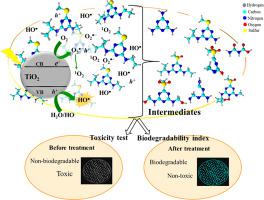Journal of Environmental Chemical Engineering ( IF 7.4 ) Pub Date : 2021-01-21 , DOI: 10.1016/j.jece.2021.105109 Rodrigo Pereira Cavalcante , Dirce Martins de Oliveira , Lucas de Melo da Silva , Jaime Giménez , Santiago Esplugas , Silvio César de Oliveira , Renato Falcao Dantas , Carme Sans , Amilcar Machulek Junior

|
In this study, we investigated the effectiveness of photocatalysis using TiO2 as catalyst on the removal of ametryn. The evaluation of photocatalytic activity under simulated sunlight was discussed as evidence by numerous controlled trials and several operational parameters such as ametryn concentration, total organic carbon, chemical oxygen demand, specific UV absorbance, biochemical oxygen demand, toxicity and formed intermediates. Moreover, the roles of reactive species involved in the degradation of ametryn were examined by using different specific scavengers. Ametryn removed by photocatalysis using 0.4 g L−1 of TiO2 was 100% within 60 min, while only 30% was achieved by photolysis at the same time. Biodegradability index improved from 0.3 (raw solution) up to 0.8 while the acute toxicity measured by the inhibition percentage of bioluminescence from Vibro fischeri indicates that the photocatalytic treatment promotes 97% of toxicity reduction. The scavenger study shows different percentages of inhibition in ametryn degradation, which allowed to conclude that HO•, valence-band holes and O2•− could intervene in the degradation of ametryn, with predominance of HO•. Thirty-eight intermediates were identified from the photocatalytic degradation of ametryn. The comparison of the generation of those intermediates with and without the addition of scavengers showed that different by-products are generated depending on the predominance of the active species. For example, the presence of azide resulted in intermediates formed by condensation reactions. Based on the identified intermediates, reaction pathways and a degradation mechanism were proposed, including HO• radicals, O2•−, holes, and 1O2.
中文翻译:

评估a草除草剂及其副产物的TiO 2光催化降解中涉及的主要活性物质
在这项研究中,我们研究了使用TiO 2作为催化剂的光催化去除甘蓝素的有效性。众多对照试验和几个操作参数,如a草素浓度,总有机碳,化学需氧量,比紫外线吸收率,生化需氧量,毒性和形成的中间体,讨论了在模拟阳光下评估光催化活性的证据。此外,通过使用不同的特异性清除剂检查了反应性物质在紫杉醇降解中的作用。使用0.4 g L -1的TiO 2通过光催化除去六氢萘苯60分钟内100%是100%,而同时光解只能达到30%。从0.3(原料溶液)提高生物降解性指数高达0.8,同时通过从生物发光的抑制百分比来测量的急性毒性的Vibro鲵表示光催化处理促进毒性减少的97%。清除剂研究显示了对紫杉醇降解的不同抑制百分比,这可以得出结论,HO •,价带孔和O 2 •-可以干预紫杉醇的降解,其中HO •占优势。。从atricn的光催化降解中鉴定出38种中间体。在添加和不添加清除剂的情况下,对这些中间体的生成进行比较表明,根据活性物种的优势,会生成不同的副产物。例如,叠氮化物的存在导致通过缩合反应形成的中间体。在确定的中间体的基础上,提出了HO •自由基,O 2 •-,空穴和1 O 2的反应途径和降解机理。











































 京公网安备 11010802027423号
京公网安备 11010802027423号